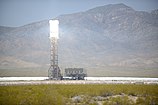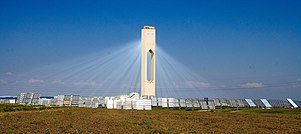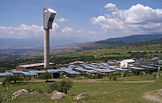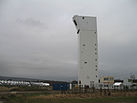Solar power tower
|
||||
Concentrating solar power towers:
|
||||
The solar power tower, also known as 'central tower' power plants or 'heliostat' power plants or power towers, is a type of solar furnace using a tower to receive the focused sunlight. It uses an array of flat, movable mirrors (called heliostats) to focus the sun's rays upon a collector tower (the target). Concentrated solar thermal is seen as one viable solution for renewable, pollution-free energy.
Early designs used these focused rays to heat water, and used the resulting steam to power a turbine. Newer designs using liquid sodium have been demonstrated, and systems using molten salts (40% potassium nitrate, 60% sodium nitrate) as the working fluids are now in operation. These working fluids have high heat capacity, which can be used to store the energy before using it to boil water to drive turbines. These designs also allow power to be generated when the sun is not shining.
The US National Renewable Energy Laboratory (NREL) has estimated that by 2020 electricity could be produced from power towers for 5.47 cents per kWh. Companies such as ESolar (backed by Google.org) are continuing development of cheap, low maintenance, mass producible heliostat components that will reduce costs in the near future. ESolar's design uses large numbers of small mirrors (1.14 m²), which reduce costs for installing mounting systems such as concrete, steel, drilling, and cranes.
Improvements in working fluid systems, such as moving from current two tank (hot/cold) designs to single tank thermocline systems with quartzite thermal fillers and oxygen blankets will improve material efficiency and reduce costs further.
Generally, installations use from 150 hectares (1,500,000 m2) to 320 hectares (3,200,000 m2).
There is evidence that such large area solar concentrating installations can kill birds that fly over them. Near the center of the array temperatures can reach 550 oC which, with the solar flux itself, is enough to incinerate birds while further away feathers are scorched leading to the eventual death of the bird. Workers at the Ivanpah solar power plant call these birds “streamers,” as they ignite in midair and plummet to the ground trailing smoke. During testing of the initial standby position for the heliostats, 115 birds were killed as they entered the concentrated solar flux. After adjusting the standby position to not focus all the solar energy into a single point, during the following 6 months of operations, a total of 321 birds were killed. However newly developed technique is available to prevent further bird fatalities.
...
Wikipedia





